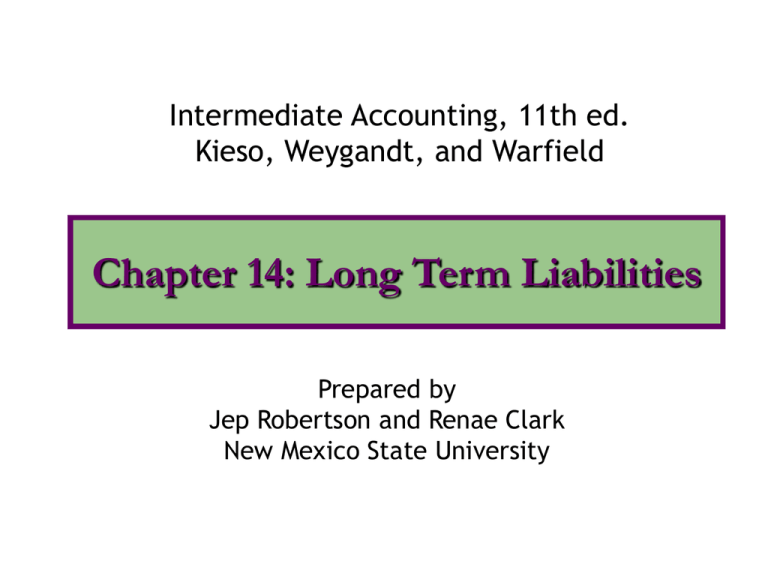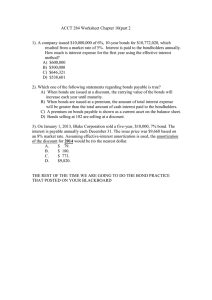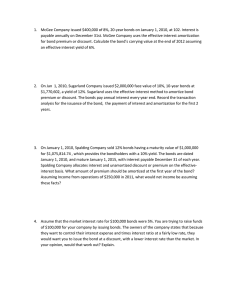
Intermediate Accounting, 11th ed.
Kieso, Weygandt, and Warfield
Chapter 14: Long Term Liabilities
Prepared by
Jep Robertson and Renae Clark
New Mexico State University
Chapter 14: Long Term Liabilities
After studying this chapter, you should
be able to:
1. Describe the format procedures associated
with issuing long-term debt.
2. Identify various types of bond issues.
3. Describe the accounting valuation for
bonds at date of issuance.
4. Apply the methods of bond discount and
premium amortization.
Chapter 14: Long Term Liabilities
5. Describe the accounting procedures for
the extinguishment of debt.
6. Explain the accounting procedures for
long-term notes payable.
7. Explain the reporting of off-balance sheet
financing arrangements.
8. Indicate how long-term debt is presented
and analyzed.
Long Term Debt: General
Long-term debt consists of probable
future sacrifices.
It has various covenants or restrictions
for the protection of both lenders and
borrowers.
The indenture agreement incorporates
the terms of the issue and restrictions.
Issuing Bonds
Bonds are the most common type of
long-term debt.
They are usually issued in denominations
of $1,000.
A bond indenture is a promise (by the
lender to the borrower) to pay:
1. a sum of money at the designated date, and
2. periodic interest at a stipulated rate on the
face value.
Selected Types of Bonds
Secured and unsecured bonds
Term or serial bonds
Callable bonds
Convertible bonds
Bearer bonds
Deep discount
Commodity-backed
Bond Issues: Parties to the
Contract
lend cash
Issuer of Bonds
Bondholders
1. Bond Certificate
2. Payment Periodic Interest
3. Payment of Face Value (maturity)
Valuation of Bonds: Determining
Bond Prices
The price of a bond issue is
determined by:
• the present value of the interest
payments, and
• the present value of the face value,
• both discounted at the market (effective)
rate of interest at date of issue.
Interest payments by borrower are
calculated as:
Face value of bond issue x Stated (face)
rate of interest
Determining Bond Prices:
Example
Given:
• Face value of bond issue:
$100,000
• Term of issue:
5 years
• Stated interest rate:
9% per year,
payable annually end of the year
• Market rate of interest:
11%
What is the issue price of the bonds?
Determining Bond Prices:
Example: Cash Flows
Year 1
Interest $9,000
Year 2
$9,000
Year 3
$9,000
Year 4
Year 5
$9,000
Redemption at maturity ==>
$9,000
$100,000
face value
Interest = $100,000 x 9% per year stated rate
Determining Bond Prices:
Example: Present Value of Cash
Flows
Year 1
Interest $9,000
$ 33,263
plus
$ 59,345
Year 2
Year 3
$9,000
$9,000
Year 4
$9,000
Year 5
$9,000
Discount at market rate, 11%
$9,000 x 3.69590
Discount at market rate, 11%
$100,000 x 0.59345
=$92,608 is the issue price
$100,000
Bond Issue Pricing: Concept
Relationship
between
Stated rate
and market rate
Relationship
between
Issue Price
and face value
S.R. = Mkt Rate
Issue Price = F.V.
S.R. < Mkt Rate
Issue Price < F.V.
S.R. > Mkt Rate
Issue Price > F.V.
Discount on Bonds Payable
A discount is amortized either by the straight
line method or the effective interest method.
The effective method is preferred GAAP.
Interest expense is recognized as follows:
Cash paid for interest:
$XXX
Add: Discount amortized
$XXX
during period:
Interest expense recognized: $XXX
Premium on Bonds Payable
A premium is amortized either by the
straight line method or the effective
interest method.
Interest expense is recognized as
follows:
Cash paid for interest:
$XXX
Less: Premium amortized
during period:
$XXX
Interest expense recognized:
$XXX
Straight-Line Method
Under this method of amortization an
equal amount of interest expense and
discount/premium amortization is
recognized each period.
The amount to amortize each period =
Total Discount/Premium
Total Number of Periods
Effective-Interest Method
This method results in a different
interest expense and amount of
discount/premium amortized each
period.
Bond interest expense =
Beginning Period’s Carrying Value x Effective
Rate at Time of Issuance
Discount/premium amortized =
The difference between interest expense and
interest to be paid (plug)
Bond Discount and Premium
Amortization Computation
Classification of Discount on
Bonds Payable
Discount on bonds payable is a contra
liability account and is shown as:
Bonds Payable (face value) :
$ XXX
less: Unamortized Discount :
($ XX)
Bonds Payable (carrying value): $ XXX
Classification of Premium on
Bonds Payable
Premium on bonds payable is an
adjunct account and is shown as:
Bonds Payable (face value) :
$ XXX
add: Unamortized Premium :
$ XX
Bonds Payable (carrying value): $ XXX
A Note on Amortization Methods
• The straight-line method allocates the
same amount of discount (or premium)
to each interest period.
• The effective-interest method allocates
the discount or premium in increasing
amounts over the bond term.
• However, the total discount or premium
amortized is the same under both
methods.
Bonds Issued on Interest Date
May be issued at par:
Cash
Bonds Payable
May be issued at a discount:
Cash
Discount on Bonds Payable
Bonds Payable
May be issued at a premium:
Cash
Premium on Bonds Payable
Bonds Payable
Bonds Issued Between Interest
Dates
• Bonds may be issued between interest
dates.
• Interest, for the period between the issue
date and the last interest date, is collected
with the issue price of the bonds (accrued
interest).
• At the specified interest date, interest is
paid for the entire interest period (semiannual or annual).
• Premium or discount are also amortized
from the date of issue of the bonds to the
end of the interest period.
Accounting for the Costs of
Issuing Bonds
Costs of issue must be amortized over
the life of the bond issue.
Even though both straight-line and
effective-interest methods are
acceptable, the straight-line method is
used in most cases.
Extinguishment of Debt
If extinguished at maturity there is
no gain or loss.
When debt is extinguished early:
1. Amortization must be brought up to
date, and
2. Any bond issue costs must be amortized
up to date of extinguishment.
LT Notes Payable and Bonds
Payable: A Comparison
Notes payable and bonds payable are
similar in that:
both have fixed maturity dates
both have either stated or implicit rates
Like a bond, a note payable is valued
at the present value of its future
interest payments and face value (at
maturity date).
Zero-Interest Bearing Notes
If a zero-interest bearing note is
issued for cash:
1. Present value is measured by cash
received.
2. Implicit interest rate is that rate that
equates the cash received with the
future payment amount(s).
3. Any discount/premium is amortized
over term of the note.
Interest Bearing Notes
If interest bearing note is issued for
cash the accounting is similar to
bonds payable.
Any discount or premium is amortized
over the term of the note.
Notes payable is credited in lieu of
bonds payable.
Notes Issued for Property, Goods,
or Services
A note may be issued for items other
than cash.
The stated interest rate is presumed
fair (and the note is recorded at face
value) unless:
1.
2.
3.
No interest is stated, or
Stated interest rate is unreasonable, or
Face amount is materially different from
current fair value.
Notes Issued for Property, Goods,
or Services
If the stated interest rate is not fair:
The present value of the note equals
the fair value of the items received.
The interest element (over and
above any stated rate) is the
difference between the face amount
of the note and the fair value of the
property.
Off-Balance Sheet Financing
Off-balance-sheet financing represents
borrowing arrangements that are not
recorded.
•
•
The amount of debt reported in the balance
sheet does not include such financing
arrangements.
The objective is to improve certain financial
ratios (such as debt-equity ratio)
Types include:
1. Non-consolidated subsidiaries
2. Special purpose entities (SPEs)
3. Operating leases
COPYRIGHT
Copyright © 2004 John Wiley & Sons, Inc. All rights reserved.
Reproduction or translation of this work beyond that permitted
in Section 117 of the 1976 United States Copyright Act without
the express written permission of the copyright owner is
unlawful. Request for further information should be addressed
to the Permissions Department, John Wiley & Sons, Inc. The
purchaser may make back-up copies for his/her own use only
and not for distribution or resale. The Publisher assumes no
responsibility for errors, omissions, or damages, caused by the
use of these programs or from the use of the information
contained herein.





